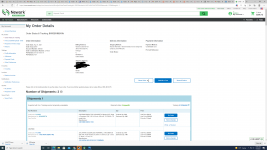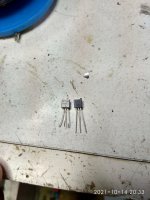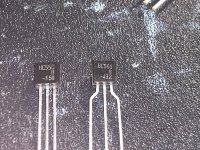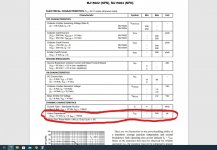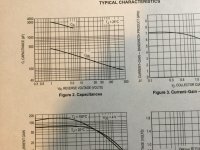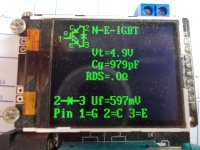Thanks bullittstang, I placed the order on August 11th, transistors shipped from UK ,my KSA992FTA look different than yours, but my kSC1845FTA look exactly like yours , I dont think my ksa992 are fake but maybe newer type of imprint. I will contack newark and ask .
Attachments
Just a bit of clarity required I think ...
Newark and Mouser and other major distributors buy direct from the manufacturers. So there's no place to get fakes into the supply chain.
It's possible that the manufacturer outsources the production of some lines of product, but they do batch checking ... what would the point be of feeding the manufacturer fakes? They'd lose the contract and potentially be sued almost instantly!
Where the fakes enter the chain is through the appear and disappear channels like ebay and other similar sites. Small maybe legit companies buy small quantities cheap and get ripped off, and they've sold them before they discover they've been duped.
So, if I order from the major distributors, I feel confident that semiconductors I buy aren't fakes.
The worst part is it's usually the out of production products that get faked.
Newark and Mouser and other major distributors buy direct from the manufacturers. So there's no place to get fakes into the supply chain.
It's possible that the manufacturer outsources the production of some lines of product, but they do batch checking ... what would the point be of feeding the manufacturer fakes? They'd lose the contract and potentially be sued almost instantly!
Where the fakes enter the chain is through the appear and disappear channels like ebay and other similar sites. Small maybe legit companies buy small quantities cheap and get ripped off, and they've sold them before they discover they've been duped.
So, if I order from the major distributors, I feel confident that semiconductors I buy aren't fakes.
The worst part is it's usually the out of production products that get faked.
Here the question is not so much the outsourcing of the production of the transistor (the die).
Here the question is the outsourcing of the packaging: die mount, wire bonding, molding and laser marking. (Also final test.)
It is quite common that the packaging is done by subcontractors. The subcons often change and large companies with large production volumes often have multiple subcons for packaging and test. Some companies have one or more captive (owned) assembly and test sites and one or more subcons for assembly and test.
Only so much can be told by visual inspection of the external packaging.
Here the question is the outsourcing of the packaging: die mount, wire bonding, molding and laser marking. (Also final test.)
It is quite common that the packaging is done by subcontractors. The subcons often change and large companies with large production volumes often have multiple subcons for packaging and test. Some companies have one or more captive (owned) assembly and test sites and one or more subcons for assembly and test.
Only so much can be told by visual inspection of the external packaging.
Is the one on the right supposed to be a generic? The one on the left claims to be Fairchild? So is the one on the left fake and the one on the right a generic?
Or is the one on the left genuine Fairchild and the one on the right is supposed to be a generic BC550C but is not like a BC550C in characteristics?
Or is the one on the left genuine Fairchild and the one on the right is supposed to be a generic BC550C but is not like a BC550C in characteristics?
In your picture :Can you recognise the fake?
The one on the right is actually Onsemi , it looks authentic,
I am not 100% about the one on the left, but I think it is authentic too. So my answer is "No fakes "!
Here is a picture of 2 onsemi transistors.
Attachments
Last edited:
Is the one on the right supposed to be a generic? The one on the left claims to be Fairchild? So is the one on the left fake and the one on the right a generic?
Or is the one on the left genuine Fairchild and the one on the right is supposed to be a generic BC550C but is not like a BC550C in characteristics?
The one on the right bought from Mouser so it is absolutely genuine.
The one on the left salvaged from a bord that never worked!
I don't know why,it isn't mine.I received the board as a donation from a German guy.
If the one on the left has a painted front, then I would say it's an older genuine fairchild. The fact that it was in a used board would tend to confirm that.
As someone said, there is no money to be made in counterfeiting these essentially general purpose transistors! And they are essentially general purpose transistors ... so printing a code on them will cost them as much as the original unlabelled device!
And the crazy part is nearly any transistor will work in a GP application. It's where we want specific specs, like tighter hfe tolerance, or specific f range etc. where they won't and then you're not likely to order a GP transistor!
As someone said, there is no money to be made in counterfeiting these essentially general purpose transistors! And they are essentially general purpose transistors ... so printing a code on them will cost them as much as the original unlabelled device!
And the crazy part is nearly any transistor will work in a GP application. It's where we want specific specs, like tighter hfe tolerance, or specific f range etc. where they won't and then you're not likely to order a GP transistor!
These subcontractors are quite large operations, ISO approvals etc.It is quite common that the packaging is done by subcontractors. The subcons often change and large companies with large production volumes often have multiple subcons for packaging and test. Some companies have one or more captive (owned) assembly and test sites and one or more subcons for assembly and test.
Only so much can be told by visual inspection of the external packaging.
If they ever get detected faking, they will go out of business, nobody would touch them again.
Extrapolate the curves to “zero” volts, and measure with a DMM that has capacitance function. Works well enough. Look for 600 pF or more collector to base, and 4500-7000 from emitter to base.
What he said ^. Usually these large MJ devices read 500-700pf base to collector. I use this method to check if someone sold me a fake part.
This does indeed help detect fakes. I recently started adding qty 1 of "reference" devices to my orders from authorized distributors for a few devices that I did not have a reference for. That allowed me to measure capacitance (and hFE versus current) on a reference device to compare against online purchases.
With the M328 tester you can bend one lead away at a time and measure capacitance of BC and BE. (Another option.)
The result showed that the MJE15032 and MJE15033 were fake along with the IRF MOSFETs. (And FYI also TIP35, 36, 41, 42, 142, 147.) It has reached the point where if I thought an online purchased part was genuine it was only because I did not test it enough. Anyways I am pretty much 100% authorized distributor only at this point. BJT, MOSFET, Opamps, etc: Watch out.
With the M328 tester you can bend one lead away at a time and measure capacitance of BC and BE. (Another option.)
The result showed that the MJE15032 and MJE15033 were fake along with the IRF MOSFETs. (And FYI also TIP35, 36, 41, 42, 142, 147.) It has reached the point where if I thought an online purchased part was genuine it was only because I did not test it enough. Anyways I am pretty much 100% authorized distributor only at this point. BJT, MOSFET, Opamps, etc: Watch out.
Or if you happen to be in a shop somewhere, and the only thing you have to measure with is the shop keeper’s multimeter. I did this at Skycraft all the the time back in the day. Had surprisingly little trouble with fakes - most of the parts had been around since dinosaurs walked the earth.
What he said ^. Usually these large MJ devices read 500-700pf base to collector. I use this method to check if someone sold me a fake part.
How long do you keep the multimeter probes connected to the base and collector of the transistor?
Thanks
- Home
- Design & Build
- Parts
- My Transistors, original or copy?
